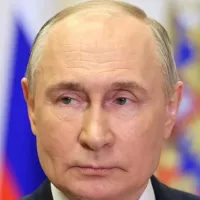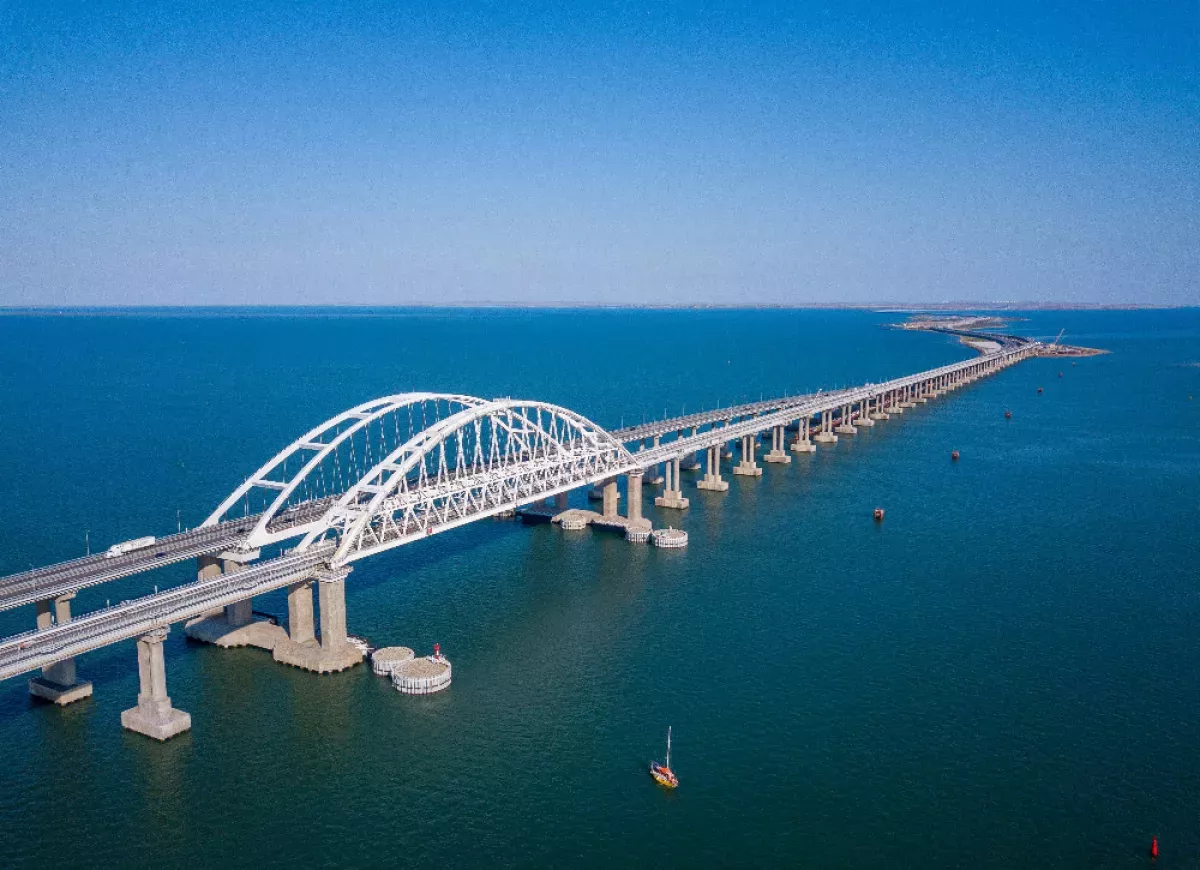The Crimean Bridge, also known as the Kerch Strait Bridge, is a significant infrastructure project consisting of parallel road and railway bridges connecting the Taman Peninsula in Russia to the Kerch Peninsula in Crimea. Built by Russia following its 2014 annexation of Crimea, the bridge spans 19 kilometers (12 miles), making it the longest bridge in Europe and the longest ever constructed by Russia. The project involved a substantial investment of ₽227.92 billion (US$3.7 billion).
April 1943: German Bridge Construction and Destruction
German forces began building a combined road and railway bridge across the Kerch Strait in April 1943. However, they destroyed the completed parts and the ropeway upon their retreat.
June 1943: German Ropeway Completion
The German Organisation Todt completed a ropeway across the Kerch Strait in June 1943, with a daily capacity of 1,000 tonnes.
1944: Soviet Temporary Bridge Construction Begins
The Soviet Union started building a 4.5 km railway bridge across the Kerch Strait in late 1944.
February 1945: Soviet Bridge Destroyed by Ice
The temporary railway bridge built by the Soviet Union across the Kerch Strait was destroyed by ice flows in February 1945. Design and construction flaws contributed to its collapse.
1949: Soviet Order for Two-Tier Bridge
In 1949, the Soviet government ordered the construction of a 5.969-kilometer, two-tier bridge combining road and rail across the Kerch Strait.
1950: Bridge Construction Halted, Ferry Line Established
Construction of the planned two-tier bridge across the Kerch Strait was halted in 1950, and a ferry line was set up instead.
1991: Discussions on an International Bridge
Despite the dissolution of the Soviet Union in 1991, the idea of a bridge linking Ukraine and Russia across the Kerch Strait persisted, with discussions and proposals continuing.
2006: Ukraine Reconsiders Bridge Construction
The Cabinet of Ministers of Ukraine reconsidered the construction of a bridge across the Kerch Strait in 2006, signaling a potential shift in policy.
2011: Ukrainian Study Favors Specific Route
A 2011 study by the Ukrainian government identified a preferred route for the Kerch Strait bridge between Cape Fonar and Cape Maly Kut.
November 2013: Increased Interest in Bridge Construction
The shelving of the Ukraine-European Union Association Agreement in November 2013 led to heightened interest and discussions surrounding the construction of the Kerch Strait bridge.
December 2013: Bridge Agreement Signed
An agreement to build the Kerch Strait bridge was formally signed as part of a broader Ukrainian-Russian action plan in December 2013.
February 2014: Russia Initiates Feasibility Study
Russia instructed Avtodor to conduct a feasibility study for the Kerch Strait bridge in February 2014, aiming for publication in 2015.
March 2014: Russia Announces Construction of Crimean Bridge
In March 2014, following the annexation of Crimea, Russia announced its plan to construct the Kerch Strait bridge, aiming to connect the annexed territory with the Russian mainland. This strategic move was intended to integrate Crimea into Russia, reduce Ukrainian influence, and establish a physical and symbolic link between the territories.
March 2014: Putin Announces Crimean Bridge Project
One day after Russia formally claimed Crimea in March 2014, President Vladimir Putin announced the plan to build a road-and-rail bridge across the Kerch Strait, connecting Crimea to mainland Russia.
2014: Initial Bridge Design Scrapped Due to Risks
In 2014, the initial design for the Crimean Bridge, which included parallel road and rail bridges along with a causeway on the Tuzla Spit, was abandoned. The decision to scrap this plan was driven by concerns about the instability of the Tuzla Spit and the risks associated with relying on a causeway in such conditions.
January 2015: Construction Contract Awarded to SGM Group
In January 2015, the construction contract for the Crimean Bridge was awarded to SGM Group, a company owned by Arkady Rotenberg, a close associate of Putin, despite the company's lack of experience in bridge building and the international sanctions imposed on Rotenberg due to Russia's actions in Ukraine.
January 2015: Construction Contract Awarded
In January 2015, the contract to build the Crimean Bridge was given to a company called Stroygazmontazh, owned by Arkady Rotenberg.
May 2015: Preliminary Work Commences on Crimean Bridge
Preliminary work on the Crimean Bridge project began in May 2015, marking the start of the construction phase. The discovery of WWII-era explosives and aircraft during site clearance highlights the historical significance of the area.
October 2015: First Temporary Bridge Completed for Crimean Bridge Construction
By October 2015, the first temporary bridge, crucial for facilitating construction access regardless of weather conditions, was finished, connecting Tuzla Island and the Taman Peninsula.
February 2016: Construction Begins
Construction of the Crimean Bridge commenced in February 2016, marking a significant step in the project's timeline.
February 2016: Main Construction of Crimean Bridge Begins
The main construction phase of the Crimean Bridge commenced in February 2016, marking a significant milestone in the project's timeline.
April 2016: First Pillar of Crimean Bridge Road Section Erected
In April 2016, the first pillar of the road bridge was erected, signifying tangible progress in the construction process.
August 2017: Ferry Traffic Record
In August 2017, the Kerch Strait ferry reached its peak traffic record, which would later be surpassed by the Crimean Bridge.
August 2017: Foundations of Crimean Bridge Road Section Completed
The foundations for the Crimean Bridge's road section were finished by August 2017, demonstrating substantial progress in the project's structural development.
October 2017: Russia Establishes Maritime Brigade to Protect Crimean Bridge
In October 2017, recognizing the bridge's strategic importance, Russia announced the formation of a specialized maritime brigade to ensure its security, reflecting the growing militarization of the region.
December 2017: All Road Pillars and Spans of Crimean Bridge Completed
By December 2017, all the road pillars and spans for the Crimean Bridge were completed, indicating the near completion of the road section's structure.
December 2017: Bridge Naming
Following an online vote in December 2017, the bridge was officially named "Crimean Bridge," with "Kerch Bridge" and "Reunification Bridge" as the second and third most popular choices.
April 2018: Crimean Bridge Road Section Deemed Ready for Operation
After rigorous examination, the Crimean Bridge's road section was deemed ready for operation in April 2018, paving the way for its imminent opening.
May 2018: Shipping Restrictions Increase
Following the Crimean Bridge's opening in May 2018, there was a notable increase in shipping restrictions, including inspections of ships by Russian authorities.
May 2018: Crimean Bridge Road Section Officially Opens
In a symbolic display, President Putin led a convoy of trucks across the Crimean Bridge in May 2018, marking its official inauguration. This event solidified Russia's control over Crimea and underscored the bridge's strategic and political significance.
May 2018: Road Bridge Inauguration and Opening
Russian President Vladimir Putin inaugurated the road section of the Crimean Bridge in May 2018. It opened to cars on May 16th and to trucks on October 1st the same year.
May 2018: Road Bridge Opens
The road section of the Crimean Bridge opened in May 2018, quickly becoming the preferred route between Crimea and Russia.
August 2018: Bridge Traffic Peaks
The Crimean Bridge experienced peak traffic in August 2018, with a single-day record of over 32,000 vehicles crossing on August 5th and even higher numbers in the following days.
October 2018: Ukrainian Shipping Impacted
By October 2018, Ukrainian shipping from its Sea of Azov ports had reportedly decreased by about 25% due to the restrictions imposed after the Crimean Bridge's opening.
October 2018: Truck Traffic Shifts to Bridge
Following the opening of the Crimean Bridge to trucks in October 2018, truck transportation via the Kerch Strait ferry virtually ceased, highlighting the bridge's impact on transportation methods.
October 2018: Railway Span Accident
In October 2018, a railway span being lowered into place tilted and fell into the sea during the construction of the Crimean Bridge. This incident occurred in the sea section between Tuzla Spit and Tuzla Island.
November 2018: Railway Pillar Completion
Despite the setback in October 2018, construction continued, and the installation of the railway pillars for the Crimean Bridge was completed in November 2018.
November 2018: Kerch Strait Incident
In November 2018, a significant geopolitical event, the Kerch Strait incident, occurred near the Crimean Bridge. The Russian navy claimed three Ukrainian vessels entered their territorial waters, leading to their seizure and the arrest of their crews, escalating tensions between the nations.
December 2018: UN Condemns Crimean Bridge Construction
Since December 2018, the United Nations General Assembly has consistently condemned the construction and opening of the Crimean Bridge, citing its role in further militarizing Crimea and restricting maritime access to Ukrainian ports in the Azov Sea. Russia, however, maintains its stance that the bridge is necessary infrastructure for its citizens and does not require external permission for its construction.
March 2019: Railway Span Construction Completed
Marking a significant milestone, the construction of all railway spans for the Crimean Bridge was completed in March 2019.
May 2019: Road Bridge Traffic Surpasses Ferry
By May 2019, after a year of operation, the Crimean Bridge had served three times more traffic than the Kerch Strait ferry had in all of 2017, demonstrating its significance as a transportation route.
October 2019: Freight Train Opening Postponed
The opening of the Crimean Bridge to freight trains was postponed until 2020. This delay was officially attributed to the discovery of an ancient site on the Kerch Peninsula, which impacted the construction of the connecting railroad.
November 2019: Train Ticket Sales Begin
In November 2019, train ticket sales for travel across the Kerch Strait via the Crimean Bridge began.
December 2019: Railway Bridge Opens
Deemed ready for operation, the railway section of the Crimean Bridge was formally opened by President Putin on December 23, 2019. This followed the commencement of the first scheduled passenger train service on December 25, 2019.
December 2019: Rail Bridge Inauguration
The railway section of the Crimean Bridge was officially inaugurated in December 2019. Regular passenger train services began crossing the bridge two days later.
June 2020: Freight Train Operations Commence
After a delay, the Crimean Bridge was opened for freight train operations in June 2020, expanding its transportation capacity.
August 2020: Record Traffic Volume
The Crimean Bridge experienced a record volume of traffic on August 15, 2020, with 36,393 cars crossing, highlighting its significance as a transportation artery.
February 2022: Ukraine Calls for Destruction of Crimean Bridge
Following the Russian invasion of Ukraine in February 2022, Ukraine called for the destruction of the Crimean Bridge, considering it a legitimate military target. This call drew criticism from Russia, with Kremlin Press Secretary Dmitry Peskov emphasizing the need to protect the bridge.
October 2022: First Explosion on the Crimean Bridge
In October 2022, a significant explosion occurred on the Crimean Bridge, causing a partial collapse of the road section and igniting a fire on a train carrying fuel tankers. While Ukraine hinted at its involvement, Russia attributed the blast to "Ukrainian terrorism."
October 2022: Explosion and Partial Collapse
In October 2022, an explosion on the Crimean Bridge caused sections of the road bridge to collapse and ignited a fire on the rail bridge, significantly disrupting traffic flow. Ukraine claimed responsibility for the attack.
January 2023: Installation of New Spans Begins on Crimean Bridge
In January 2023, the installation of new spans on the Crimean Bridge's automobile section commenced, marking a step toward its restoration following the damage inflicted in the previous year. This development underscores Russia's commitment to maintaining the bridge's functionality.
February 2023: Road Bridge Reopening
Following repair work, the road section of the Crimean Bridge was fully reopened to traffic in February 2023.
February 2023: Crimean Bridge Reopens to Road Traffic
On February 23, 2023, the Crimean Bridge's road section was fully reopened to vehicular traffic, signifying a return to normalcy after the October 2022 explosion and subsequent repairs.
July 2023: Second Explosion and Collapse
Another explosion occurred on the Crimean Bridge in July 2023, causing further damage and leading to a section collapsing. Ukraine claimed responsibility for this attack as well.
July 2023: Repairs Ordered for Crimean Bridge After Explosion
Following the October 2022 explosion, Russian authorities ordered repairs for the Crimean Bridge to be completed by July 2023. This deadline highlights the significance of the bridge for Russia's strategic operations in Crimea.
July 2023: Zelensky Calls Crimean Bridge a Legitimate Military Target
In July 2023, Ukrainian President Volodymyr Zelenskyy, during a speech at the Aspen Security Forum, labeled the Crimean Bridge a legitimate military target, justifying its neutralization due to its role in transporting military supplies to the Crimean Peninsula, which Ukraine views as crucial to the ongoing conflict.
July 2023: Second Explosion on the Crimean Bridge
In July 2023, a second explosion struck the Crimean Bridge, resulting in the complete collapse of at least one section of the road bridge and the suspension of rail services. This attack, attributed to Ukrainian unmanned surface vessels by both Ukrainian and Russian sources, caused two fatalities and one injury.
July 2023: Crimean Bridge Suffers Significant Damage in Second Attack
On July 17, 2023, two explosions severely damaged the Crimean Bridge, leading to the complete collapse of a road section and the suspension of rail services. The attack, attributed to Ukrainian aquatic drones, resulted in two deaths and one injury, highlighting the vulnerability of the bridge despite increased security measures.
August 2023: Third Attack on the Bridge
The Crimean Bridge was targeted again in an attack in August 2023, demonstrating its vulnerability and the ongoing tensions in the region.
Mentioned in this timeline

Vladimir Vladimirovich Putin is a Russian politician and former intelligence...
Ukraine is a large country in Eastern Europe second in...
The Union of Soviet Socialist Republics USSR existed from to...
Russia officially the Russian Federation is a transcontinental country spanning...

Trains are a connected series of vehicles traveling on railway...

Fire is a rapid oxidation process called combustion releasing heat...
Trending

Simon Cowell is a prominent English television personality and businessman recognized for his role as a judge on various talent...

7 months ago Gary Payton Reflects on Jordan Matchup and Hypothetical Stats in Today's NBA

11 days ago Spurs Defeat Nuggets in Thrilling Game, Mavericks Face Nuggets

22 days ago Michael Douglas and Catherine Zeta-Jones Celebrate 25 Years of Marriage with Throwbacks
Luke Kornet is an American professional basketball player currently playing for the San Antonio Spurs in the NBA He's a...

6 months ago Jack Black's Minecraft Movie Sets Premiere on HBO Max, June 20, 2025
Popular

Candace Owens is an American conservative political commentator and author...

Ilhan Omar is an American politician currently serving as the...

XXXTentacion born Jahseh Dwayne Ricardo Onfroy was a controversial yet...

Tom Cotton is an American politician and Army veteran currently...
The Kennedy Center Honors are annual awards recognizing individuals and...

Kelsey Grammer is an accomplished American actor producer and singer...
